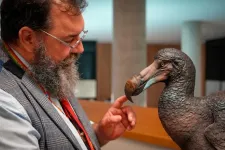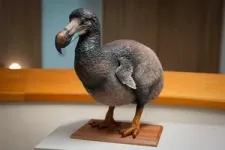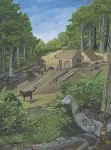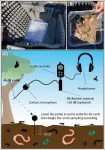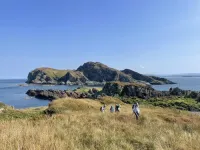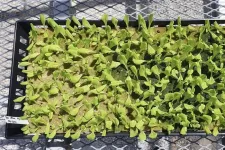(Press-News.org) Rethinking the Dodo
Review of 400 years of scientific literature corrects the record on icon of extinction
Researchers are setting out to challenge our misconceptions about the Dodo, one of the most well-known but poorly understood species of bird.
In a paper published today [16 August 2024] in the Zoological Journal of the Linnean Society researchers from the University of Southampton, Natural History Museum (NHM) and Oxford University Museum of Natural History have undertaken the most comprehensive review of the taxonomy of the Dodo and its closest relative, the Rodriguez Island Solitaire.
They’ve painstakingly gone through 400 years’ worth of scientific literature and visited collections around the UK to ensure this iconic species, embodying humanity’s destructive potential, is correctly classified.
“The Dodo was the first living thing that was recorded as being present and then disappeared,” says Dr Neil Gostling from the University of Southampton, supervising author of the paper. “Before this, it hadn’t been thought possible for human beings to influence God’s creation in such a way.
“This was a time before the scientific principles and systems we rely on to label and classify a species were in place. Both the Dodo and the Solitaire were gone before we had a chance to understand what we were looking at.”
Correcting the record
Much of what was written about the Dodo and the Solitaire was based on accounts from Dutch sailors, representations by artists, and incomplete remains.
The lack of a definitive reference point (type specimen) or convention to label species (zoological nomenclature) led to a series of misidentifications in the centuries following their extinction. New species such as the Nazarene Dodo, the White Dodo, and the White Solitaire were named, but the paper confirms that none of these creatures existed. Still, these erroneous ‘pebbles’ sent ripples through the waters of zoological literature.
“By the 18th and early 19th centuries, the Dodo and the Solitaire were considered to be mythological beasts,” says Dr Mark Young, lead author of the paper from the University of Southampton. “It was the hard work of Victorian-era scientists who finally proved that the Dodo and the Solitaire were not mythological but were giant ground doves.”
“Unfortunately, no one could agree how many species there had been,” continues Dr Young. “Throughout most of the 19th and 20th centuries, researchers thought there were three different species, although some people thought there had been four or even five different species.”
To unpick this confusion, researchers went through all the literature on the Dodo and Rodriguez Solitaire encompassing hundreds of accounts dating back to 1598 and visited specimens around the UK, including the world’s only surviving soft tissue from the Dodo, in the Oxford Museum.
“More has been written about the Dodo than any other bird, yet virtually nothing is known about it in life,” says Dr Julian Hume, an avian palaeontologist at the Natural History Museum and coauthor of the paper.
“Based on centuries of nomenclatural confusion, and some 400 years after its extinction, the Dodo and Solitaire, continue to prompt heated debate. We’ve gone from where the first statements were made, seen how these have developed, and identified various rabbit holes to correct the record, as best we can.”
Through this work, researchers were able to confirm that both birds were members of the columbid (pigeon and dove) family.
“Understanding its wider relationships with other pigeons is of taxonomic importance, but from the perspective of conservation, the loss of the dodo and the solitaire a few decades later means a unique branch of the pigeon family tree was lost,” says Dr Gostling. “There are no other birds alive today like these two species of giant ground dove.”
Challenging our misconceptions
The researchers believe the popular idea of the Dodo as a fat, slow animal, predestined for extinction is flawed.
“Even four centuries later, we have so much to learn about these remarkable birds,” says Dr Young. “Was the Dodo really the dumb, slow animal we’ve been brought up to believe it was? The few written accounts of live Dodos say it was a fast-moving animal that loved the forest.”
Dr Gostling adds: “Evidence from bone specimens suggests that the Dodo’s tendon which closed its toes was exceptionally powerful, analogous to climbing and running birds alive today. The dodo was almost certainly a very active, very fast animal.
“These creatures were perfectly adapted to their environment, but the islands they lived on lacked mammalian predators. So, when humans arrived, bringing rats, cats, and pigs, the Dodo and the Solitaire never stood a chance.
“Dodos held an integral place in their ecosystems. If we understand them, we might be able to support ecosystem recovery in Mauritius, perhaps starting to undo the damage that began with the arrival of humans nearly half a millennium ago.”
Learning ‘valuable lessons’
The study marks the beginning of a wider project to understand the biology of these iconic animals.
"The mystery of the Dodo bird is about to be cracked wide open," says Dr Markus Heller, Professor of Biomechanics at the University of Southampton, a coauthor on the paper.
"We have assembled a fantastic team of scientists to uncover the true nature of this famous extinct bird. But we are not just looking back in time - our research could help save today's endangered birds too."
Dr Heller explains: "Using cutting-edge computer technology, we are piecing together how the Dodo lived and moved. This isn't just about satisfying our curiosity. By understanding how birds evolved in the past, we are learning valuable lessons that could help protect bird species today."
"It's like solving a 300-year-old puzzle, and the solution might just help us prevent more birds from going the way of the Dodo."
The project will include work with palaeoartist Karen Fawcett, who has created a detailed, life-size model of the Dodo to bring the words on the pages of books and journal articles to life. She says: “This work has been the merging of science and art to achieve accuracy and realism so that these creatures come back from the dead, real and tangible for people to touch and see.”
The work is supported by the University of Southampton’s Institute for Life Sciences. The Institute Director, Professor Max Crispin, says: “The Institute was delighted to support this exciting work which exemplifies Southampton’s strength in interdisciplinary research and advanced scholarship.”
The systematics and nomenclature of the Dodo and the Solitaire (Aves: Columbidae), and an overview of columbid family-group nomina is published in Zoological Journal of the Linnean Society.
Ends
Contact
Steve Williams, Media Manager, University of Southampton, press@soton.ac.uk or 023 8059 3212.
Notes for editors
The systematics and nomenclature of the Dodo and the Solitaire (Aves: Columbidae), and an overview of columbid family-group nomina is published in Zoological Journal of the Linnean Society. An advanced copy of the paper is available on request.
For Interviews with Dr Neil Gostling, Dr Mark Young and palaeoartist Karen Fawcett please contact Steve Williams, Media Manager, University of Southampton press@soton.ac.uk or 023 8059 3212.
Images available to download here: https://safesend.soton.ac.uk/pickup?claimID=HZrZoxsxfXNXpsbX&claimPasscode=qKyNnCMyC5rMvZEu
DSC00006, DSC00007, DSC00010 - Dr Neil Gostling with palaeoartist Karen Fawcett’s Dodo sculpture.
DSC00017, DSC00018, DSC00019 - Palaeoartist Karen Fawcett’s Dodo sculpture. Please credit Karen Fawcett.
Dodo dry forest scene shows the habitat in which the dodo lived along with other species native to Mauritius. Please credit Julian Pender Hume.
Solitaire shows a life reconstruction of the Solitaire of Rodrigues. Please credit Julian Pender Hume.
Dodo extinction factors shows the instruments of the Dodo’s demise, human’s habitat loss, cats and pigs as predators. Please credit Julian Pender Hume.
Solitaire territory shows the habitat on the island of Rodrigues with Solitaires amongst the vegetation. Please credit Julian Pender Hume.
Audio snippets of Dr Neil Gostling discussing the research available here: https://safesend.soton.ac.uk/pickup?claimID=xZUa7m4Hsj4oawnB&claimPasscode=MA5MR7GMRoGzVCAD&emailAddr=187784
Additional information
The University of Southampton drives original thinking, turns knowledge into action and impact, and creates solutions to the world’s challenges. We are among the top 100 institutions globally (QS World University Rankings 2023). Our academics are leaders in their fields, forging links with high-profile international businesses and organisations, and inspiring a 22,000-strong community of exceptional students, from over 135 countries worldwide. Through our high-quality education, the University helps students on a journey of discovery to realise their potential and join our global network of over 200,000 alumni. www.southampton.ac.uk
www.southampton.ac.uk/news/contact-press-team.page
Follow us on X: https://twitter.com/UoSMedia
END
Rethinking the dodo
Review of 400 years of scientific literature corrects the record on icon of extinction
2024-08-16
ELSE PRESS RELEASES FROM THIS DATE:
Arts and crafts improves your mental health as much as having a job, scientists find
2024-08-16
Could arts and crafts help protect the public’s mental health? A new study in Frontiers in Public Health provides evidence that indulging our creative side could provide everyone with a significant wellbeing boost. Because arts and crafts are relatively affordable and accessible, promoting the public’s access to artistic activities could provide a major boost to public mental health.
“Crafting and other artistic activities showed a meaningful effect in predicting people’s ...
It’s a rave – underground acoustics amplify soil health
2024-08-16
Barely audible to human ears, healthy soils produce a cacophony of sounds in many forms – a bit like an underground rave concert of bubble pops and clicks.
Special recordings made by Flinders University ecologists in Australia show this chaotic mixture of soundscapes can be a measure of the diversity of tiny living animals in the soil, which create sounds as they move and interact with their environment.
With 75% of the world’s soils degraded, the future of the teeming community of living species that live underground face a dire future without restoration, says microbial ecologist Dr Jake Robinson, from the Frontiers ...
New poll finds 50% of parents believe too much time on technology hinders kids from forming connections in the classroom
2024-08-16
COLUMBUS, Ohio (August 16, 2024) – Building positive connections with teachers and peers in the classroom can be critical to the mental health and academic success of children and adolescents. Yet, a new national poll from The Kids Mental Health Foundation, conducted by Ipsos, finds half of parents believe spending too much time on technology and social media hinder children from making meaningful connections as they head into the upcoming school year.
The poll, conducted by Ipsos on behalf of ...
How policing impacts the homeless
2024-08-16
People who are homeless often endure constant and intrusive police interactions, leaving them feeling intimidated, harassed and stigmatised, a new study finds.
More people of all ages and backgrounds are finding themselves homeless, often due to job loss or illness, as well as a lack of affordable housing. Between 2016 and 2021 homelessness increased by 5.2% in Australia.
Professor of Law Thalia Anthony from the University of Technology Sydney (UTS) said the research aimed to give a voice to people experiencing homelessness ...
Scottish and Irish rocks confirmed as rare record of ‘snowball Earth’
2024-08-16
A rock formation spanning Ireland and Scotland may be the world’s most complete record of “snowball Earth”, a crucial moment in planetary history when the globe was covered in ice, finds a new study led by UCL (University College London) researchers.
The study, published in the Journal of the Geological Society of London, found that the Port Askaig Formation, composed of layers of rock up to 1.1km thick, was likely laid down between 662 to 720 million years ago during the Sturtian glaciation – the first of two global freezes thought to have ...
Research provides a roadmap for improving electrochemical performance
2024-08-16
Thomas Edison went through thousands of materials before he finally found the right tungsten filament to create a working lightbulb. This type of trial-and-error research continues today and is responsible for countless inventions that improve our world. Battery systems that help power our lives in many seen (and unseen) ways are one example.
However, improving these materials and devices requires more than experimentation. Modern engineers must also form a deeper understanding of the general principles that govern material performance, from which they can design better materials to achieve challenging product requirements.
In a paper ...
Females’ and males’ muscles differ in sugar and fatty acid handling
2024-08-16
Females’ and males’ muscles differ in glucose and fatty acid handling – but regular physical activity quickly triggers similar beneficial metabolic changes in the muscles of both sexes, new research to be presented at this year’s Annual Meeting of the European Association for the Study of Diabetes (EASD) (Madrid, 9-13 September) has found.
Exercise has a potent effect on skeletal muscle and is the most effective strategy to prevent weight loss-related muscle loss and type 2 diabetes. ...
USDA-NIFA awards $300K to study food safety, plant pathogens and pests in hydroponics
2024-08-15
FAYETTEVILLE, Ark. — As controlled environment agriculture and vertical farming gain a greater foothold in modern agriculture, a new $300,000 grant aims to enhance hydroponic lettuce production.
Kristen Gibson, director of the Arkansas Center for Food Safety and Arkansas Agricultural Experiment Station faculty member, is the lead researcher on the grant from the U.S. Department of Agriculture’s National Institute of Food and Agriculture. Gibson says the grant provides an opportunity to meet the needs of the hydroponics industry.
“The industry is always looking for what’s going to help them grow the best product, increase profit and ...
YALE NEWS: Brain wiring is guided by activity even in very early development
2024-08-15
New Haven, Conn. — In humans, the process of learning is driven by different groups of cells in the brain firing together. For instance, when the neurons associated with the process of recognizing a dog begin to fire in a coordinated manner in response to the cells that encode the features of a dog — four legs, fur, a tail, etc. — a young child will eventually be able to identify dogs going forward. But brain wiring begins before humans are born, before they have experiences or senses like sight to guide this cellular circuitry. How does that happen?
In a new ...
Eyes on the field: How Texas A&M researchers are working to revolutionize NFL officiating
2024-08-15
Hamza Memon and Nicholas Panzo, students at Texas A&M University School of Engineering Medicine (ENMED), are leading an innovative project at the intersection of sports and ophthalmology to improve National Football League (NFL) officiating . Rooted deeply in Houston’s vibrant sports culture, these Class of 2026 students combine their interest in ophthalmology and their love for sports to contribute significantly to a groundbreaking project with the NFL.
The two students met during a summer engineering program and quickly bonded over their shared aspirations in sports and ophthalmology. This friendship led ...
LAST 30 PRESS RELEASES:
How does age affect recovery from spinal cord injury?
Novel AI tool offers prognosis for patients with head and neck cancer
Fathers’ microplastic exposure tied to their children’s metabolic problems
Research validates laboratory model for studying high-grade serous ovarian cancer
SIR 2026 delivers transformative breakthroughs in minimally invasive medicine to improve patient care
Stem Cell Reports most downloaded papers of 2025 highlight the breadth and impact of stem cell research
Oxford-led study estimates NHS spends around 3% of its primary and secondary care budget on the health impacts of heat and cold in England
A researcher’s long quest leads to a smart composite breakthrough
Urban wild bees act as “microbial sensors” of city health.
New study finds where you live affects recovery after a hip fracture
Forecasting the impact of fully automated vehicle adoption on US road traffic injuries
Alcohol-related hospitalizations from 2016 to 2022
Semaglutide and hospitalizations in patients with obesity and established cardiovascular disease
Researchers ‘listen in’ to embryo-mother interactions during implantation using a culture system replicating the womb lining
How changing your diet could help save the world
How to make AI truly scalable and reliable for real-time traffic assignment?
Beyond fragmented markets: A new framework for efficient and stable ride-pooling
Can shape priors make road perception more reliable for autonomous driving?
AI tracks nearly 100 years of aging research, revealing key trends and gaps
Innovative techniques enable Italy’s first imaging of individual trapped atoms
KIER successfully develops Korea-made “calibration thermoelectric module” for measuring thermoelectric device performance
Diversifying US Midwest farming for stability and resilience
Emphasizing immigrants’ deservingness shifts attitudes
Japanese eels, climate change, and river temperature
Pusan National University researchers discover faster, smarter heat treatment for lightweight magnesium metals
China’s 2024 Gastroenterology Report: marked progress in endoscopy quality and disease management
Pusan National University researchers uncover scalable method for ultrahigh-resolution quantum dot displays
Researchers use robotics to find potential new antibiotic among hundreds of metal complexes
Gut bacteria changes at the earliest stages of inflammatory bowel disease
Scientists develop new way to “listen in” on the brain’s hidden language
[Press-News.org] Rethinking the dodoReview of 400 years of scientific literature corrects the record on icon of extinction
